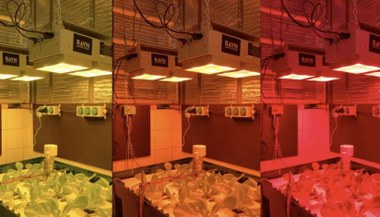Today's light research helps determine the agriculture of the future (into space)
(09-11-2021) Professor Kathy Steppe from the Faculty of Bioscience Engineering talks about the use of lights to grow crops in dark conditions, possibly even in space.
Yes, of course plants need light to grow - we all remember this from biology class. But light does not only influence plant growth, it does so much more. Professor Kathy Steppe from the Faculty of Bioscience Engineering is excited about the insights her plant research is producing. Possibilities that reach into space.
Let's refresh our memory, why is light important for plant growth? Kathy Steppe: "Light is important for photosynthesis, the process by which plants produce sugars that allow them to grow. The sugars are formed from CO2 that the plant's leaves absorb during the day. But the conversion of CO2 into sugars can only happen if the plant receives enough light. No light, no photosynthesis and therefore no growing plants. Or reasoned even further: no light, no photosynthesis, no oxygen, no human.
Light intensity plays an enormous role in the growth of plants and crops. The difference between natural light outside and artificial light is enormous. "On a sunny day, the light outside is fifty times more intense than inside. But even on a gloomy autumn day, natural light is ten times stronger."
Tasty tomatoes even in winter
But many crops need a lot of light to grow, like the ones we grow in greenhouses. " At home, we do not place our plants under a lamp to grow, but growers do. Especially in winter, growers add light to extend the day for the plant, as if they were growing up in an eternal summer. Tomatoes and lettuce, for example, need a lot of light to grow well."
At Ghent University, within the Agrotopia Chair we are researching, among other things, new LED technology to be used in high-tech, professional and vertical urban horticulture. We are also researching how we can make optimal use of artificial light. Which colours from the spectrum affect the growth and quality of the crops, and which are the best to mix? That way, we can also eat delicious tomatoes from Belgian greenhouses in winter. Or, for example, control the firmness or vitamin content of lettuce leaves."
Mixing colours for growth
Greenhouses are often bathed in a purple glow at night. The choice of red and blue artificial light is not a random one, Kathy explains.
"In sunlight all colours of the spectrum are present, with LED lights we can choose specific wavelengths. Traditionally, the choice was made to use red and blue light and to determine the strength according to what the plant needs at that moment in its growth. Red and blue light are absorbed by the chlorophyll in the leaves and stimulate photosynthesis, hence the choice of these colours. But we know that intact leaves absorb many more colours. Finding the ideal light spectrum for plant growth is a hot topic within plant lighting research."
To determine those right colour combinations, Kathy and her colleagues are testing newly developed LED lights from RAYN. "With these innovative lights we can select up to twelve wavelengths in the spectrum to find out which colour mixes lead to optimal crops. The answers to this question are important for our future agriculture: think of vertical farming, or even growing wheat and vegetables on Mars. And also to get the energy bill for the growers down, of course (laughs)."
Today, we can already grow food without natural light, and the possibilities of controlling plant growth and quality based on light are constantly increasing. "Not only the mix of colours, but also the ratio of colours has an impact on the growth and development of the plant. There is such a thing as far red light: depending on how high you set it in relation to red light, you can either make a plant grow very tall (fillet) or keep it very stocky. So much is already possible, but we can gain even more knowledge."
Baking bread on Mars
Mixing light is not only very important for plants, but also for the people who work in the greenhouses, Kathy notes. "If you spend even a minute in one of those typical purple-lit greenhouses, you will see everything in green when you go outside. So the impact on people is huge."
And that's relevant to consider in the context of another project Kathy and her colleagues are working on. "With the SpaceBakery consortium, a project supported by Flanders' Food, we want to be the first to bake bread on Mars. That means growing wheat in closed conditions, for example in the rocket on the way to Mars or on Mars itself. With high-tech plant sensors and a unique virtual 3D plant model we determine the most optimal and sustainable way to grow wheat in a closed biosphere."
With this 3D model, Kathy and her colleagues can fully map the interaction between plant and light. "In this way, we are contributing to one of the greatest challenges of our current generation: to produce more food on less land and with fewer resources. The right light mix is also extremely important here, because if you have to grow that wheat in purple light, you will experience stress as a human being. So finding the balance between human and plant is important in such extreme conditions."

